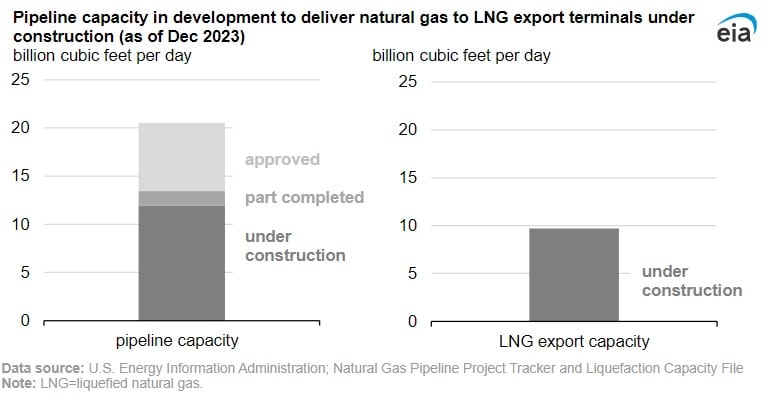U.S. LNG Exports Set to Increase Due to New Pipeline Capacity : EIA

Over 20 billion cubic feet per day (bcf/d) of gas pipeline capacity is being developed, completed to some extent or approved to transport gas to five U.S. liquified natural gas export terminals that are also currently under construction, according to the U.S. Energy Information Administration’s Natural Gas Pipeline Project Tracker. The five LNG terminals to receive the gas are Port Arthur, Golden Pass, Plaquemines, Corpus Christi Stage III and Rio Grande.
The five new LNG terminals each individually have one or more pipelines being constructed or enhanced. As it stands, 13.5 bcf/d of pipeline capacity is being built, which will directly feed into the new LNG terminals. Accordingly, U.S. LNG export capacity will significantly increase and LNG shippers can incentivise and take advantage of higher gas prices across the globe. A number of the new pipelines being built are under the jurisdiction of the Federal Energy Regulatory Commission, whilst some pipelines are under the Railroad Commission of Texas.
The Golden Pass Pipeline is developing the existing pipeline, allowing 2.5 bcf/d of gas to be delivered to the Golden Pass LNG terminal. The Port Arthur Pipeline Company proposes to build two pipelines, each with a capacity of two bcf/d to deliver gas to the Port Arthur LNG export terminal. Venture Global Gator Express, Tennessee Gas Pipeline Company and Texas Eastern Transmission proposes to build and enhance a number of pipelines, with a total capacity of 6.4 bcf/d to deliver gas from pipeline interconnections to the Plaquemines LNG export terminal.
WhiteWater Midstream is building a pipeline to deliver gas to the Corpus Christi Stage III project, with a capacity of 1.7 bcf/d. Moreover, Cheniere Corpus Christi is developing a pipeline with a capacity of 1.5 bcf/d to deliver gas from pipeline interconnections to the Corpus Christi Stage III project. The Rio Bravo Pipeline Company is building a pipeline, with a capacity of 4.5 bcf/d to deliver gas to the Rio Grande LNG terminal.
EnerKnol Pulses like this one are powered by the EnerKnol Platform—the first comprehensive database for real-time energy policy tracking. Sign up for a free trial below for access to key regulatory data and deep industry insights across the energy spectrum.
ACCESS FREE TRIAL